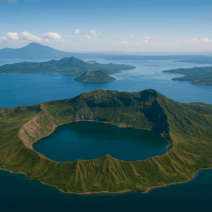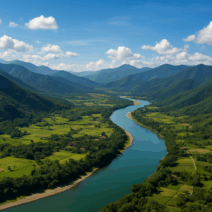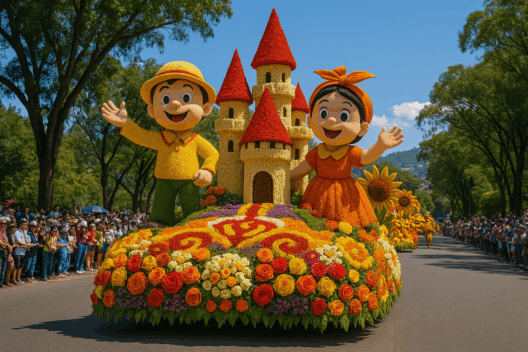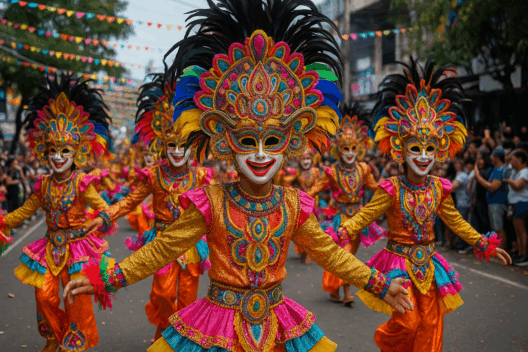QUICK SUMMARY
A vibrant celebration in Cebu honoring Santo Niño through street dancing, music, cultural performances, and a spirited display of devotion and creativity.
Every January, Cebu City comes alive with the colors, sounds, and stories of the Sinulog Festival, one of the Philippines’ most iconic cultural and religious celebrations. The festival blends Catholic devotion with pre-colonial traditions, creating a powerful expression of identity, unity, and heritage. Millions of devotees, performers, and visitors gather for processions, cultural events, and the famous Sinulog dance, forming a dynamic celebration that fills the city with energy.
Sinulog is more than a festival. It is a deeply rooted tradition—an annual reminder of Cebu’s history, faith, and living culture. This guide explores the spirit of the festival, its major highlights, and what makes it such a significant celebration for Cebuanos and Filipinos alike.
The Origins of Sinulog
The Sinulog Festival honors the Santo Niño, a symbol of childhood, protection, and Filipino Catholic identity. The image was gifted to Rajah Humabon in 1521, and its arrival marked a pivotal moment in Cebu’s history. Over time, Sinulog evolved from a devotion into a city-wide celebration filled with rituals, dances, and cultural displays.
The name “Sinulog” comes from the Cebuano word sulog, referring to water currents. The dance mimics the movement of flowing waves—two steps forward, one step back—symbolizing life’s rhythm and the spiritual journey of the people.
The Sinulog Dance: Heartbeat of the Festival
The Sinulog dance is the centerpiece of the celebration. Thousands of dancers in elaborate, colorful costumes move to the deep, resonant beat of drums, trumpets, and gongs. The movements are rhythmic, graceful, and symbolic, reflecting gratitude, faith, and devotion.
Performers represent schools, communities, cultural groups, and towns across the country. Their synchronized movements, vibrant outfits, and storytelling choreography transform city streets into a moving tapestry of color and tradition.
Grand Parade and Street Performances
The Sinulog Grand Parade is one of the most anticipated events of the festival. It stretches across Cebu City, drawing massive crowds to watch contingents perform energetic dance numbers accompanied by booming percussion and lively music.
Floats adorned with religious symbols, floral decorations, and creative themes add spectacle to the parade. The exhilarating atmosphere — filled with cheers, music, and devotion — captures the essence of Sinulog as both a cultural and spiritual event.
The Religious Processions
At its core, Sinulog remains a solemn tribute to the Santo Niño. The festival includes several religious activities such as:
- The Fluvial Procession, where an image of the Santo Niño is carried on a beautifully decorated vessel along the Mactan Channel
- The Solemn Foot Procession, attended by millions, winding through the streets of Cebu
- Novena Masses, bringing together the faithful for prayer and reflection
These events emphasize the spiritual roots of Sinulog, reminding visitors that beneath the celebration lies a deep devotion cherished for centuries.
Ritual Contests and Cultural Shows
Cebu’s creativity shines during Sinulog through various performances and competitions. Groups showcase indigenous dances, theatrical storytelling, and modern interpretations of the festival’s themes. These events highlight Cebuano artistry, revived traditions, and the cultural influences that shaped the region.
The festival also features stage performances, concerts, exhibitions, and community shows, creating a vibrant atmosphere throughout the city.
Food, Markets, and Local Life
During Sinulog, Cebu’s food culture becomes an important part of the experience. Streets fill with vendors selling lechon, puso rice, barbecue, street food, seafood dishes, and local delicacies. Night markets and pop-up stalls create festive hubs where visitors enjoy flavors that define Cebuano cuisine.
Local crafts, religious souvenirs, Sinulog shirts, and handwoven items also become popular purchases. These markets sustain local livelihoods while showcasing Cebu’s creative economy.
Safety, Organization, and Community Spirit
Cebu prepares extensively for Sinulog, ensuring crowd control, emergency response, and coordinated routes for processions and parades. Volunteers, local groups, and government units collaborate to maintain safety and order.
This shared effort reflects the spirit of bayanihan, reinforcing the idea that Sinulog is not only a celebration but also a community undertaking rooted in unity and faith.
When to Visit and What to Expect
Sinulog is held every third Sunday of January, with activities running for nearly two weeks. Travelers should expect large crowds, lively streets, and a joyful, sometimes overwhelming, festive atmosphere. Booking accommodations early is essential, as hotels fill up months in advance.
Visitors can enjoy daytime parades, nighttime concerts, cultural displays, and food fairs. The combination of sacred rituals and modern festivities creates a dynamic and unforgettable experience.
Why Sinulog Remains Unforgettable
The Cebu Sinulog Festival stands as a powerful celebration of Filipino identity, faith, and resilience. It blends spirituality with creativity, tradition with innovation, and history with modern celebration. Whether you come to watch the grand parade, join the religious processions, or simply feel the energy of Cebu during festival season, Sinulog leaves a lasting impression.
It is a celebration that honors the past, embraces the present, and inspires future generations — an enduring testament to Cebu’s cultural heart.








